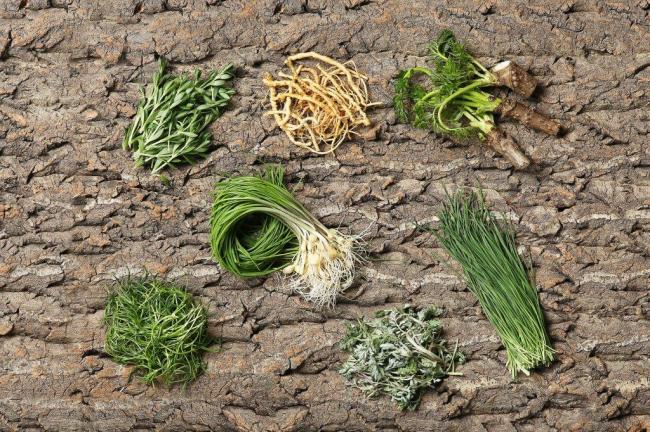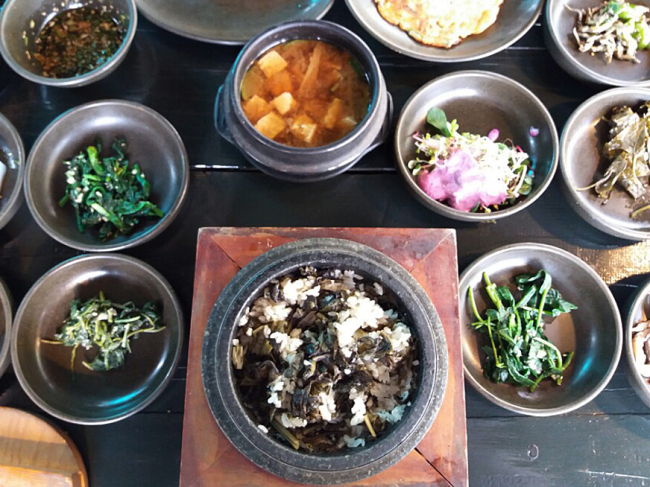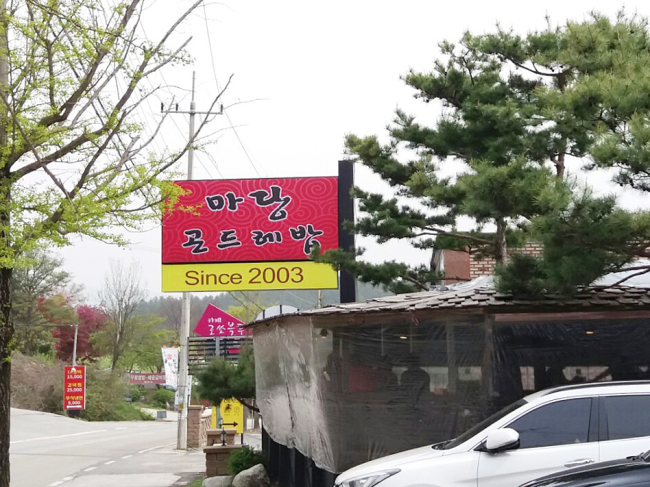As most places around the world that experience four distinct seasons, springtime is symbolic as a time of rebirth or awakening after the dormant winter months. There is no better representation of this than in the first plant shoots that emerge from the cold soils and trees as young and tender sprouts ready to bring in a new season.

In Korea springtime, is a time to enjoy the season’s culinary bounty, young spring greens known as bom namul, appreciated for their unique taste and freshness when eaten in-season. Bom namul at their peak, which spans only a month, showcases a variety of wild, foraged, and farmed herbs and greens indigenous to Korea. The varieties are endless but many popular vegetables include:
 |
Early spring vegetables, clockwise from bottom left: saebal, dallae, donnamul, sseumbawgi, dureup, yeongyang buchu, and ssuk (Photograph by Lee Kyeng-sub) |
-- Ssuk, mugwort harvested as a young green before it blooms; donnamul, a creeping succulent found in mountainous areas and known for its crunchy texture.
-- Dallae, wild chives or scapes with miniscule bulbous roots that have a mild onion flavor and found in the woodlands; saebal, a grassy herb high in beta-carotene and vitamins often sourced from the marine flatlands of Haenam, South Jeolla Province; yeongyang buchu, a long stringy member of the leek family that is sharp in taste; sseumbawgi, young dandelion sprouts with white tangled edible roots; and dureup, shoots from an indigenous Angelica bush similar in taste to a woody asparagus.
Nutrients stored in the roots during the winter make bom namul very healthful, as well as flavorful upon first pick. As the ground and air still feel a chill from winter’s departure, the seasonal switchover adds to the beauty of these unique vegetables.
Korean wild thistle is a bom namul that is known for its medicinal and health benefits. It is harvested in the spring and most often dried immediately, but if you are lucky to find a place that serves it freshly cooked do not hesitate to enjoy this earthy and herbaceous vegetable.
 |
Gondeure bap served in a stone pot (Christine Cho) |
In the eco-city of Yangpyeong, 1 1/2 hours southeast of Seoul, there are numerous restaurants that source their ingredients locally and prepare them beautifully in a scenic atmosphere and a laid back countryside ambience that makes the food taste just that much better. There you will find Madang, a popular restaurant serving gondeure bap, freshly steamed wild thistle rice served in a stone pot with an array of local vegetables that change according to what is available.
 |
Madang in Yangpyeong, Gyeonggi Province (Christine Cho) |
If you find it hard to buy these vegetables at your local mart and prepare them at home, the best places to enjoy them are at a local vegetarian restaurant. Before the advent of warmer summer days try to make a trip to the countryside where farmlands, mountains, and forests play host to these specialty vegetables, and where you can truly experience the seasonal beauty of Korean cuisine.
By Christine Cho (
thepalate@gmail.com)
Christine Cho, a Korean-American expat in Seoul, has been eating and cooking her way around the world for 16 years as a private chef. -- Ed.











![[Today’s K-pop] Blackpink’s Jennie, Lisa invited to Coachella as solo acts](http://res.heraldm.com/phpwas/restmb_idxmake.php?idx=644&simg=/content/image/2024/11/21/20241121050099_0.jpg)